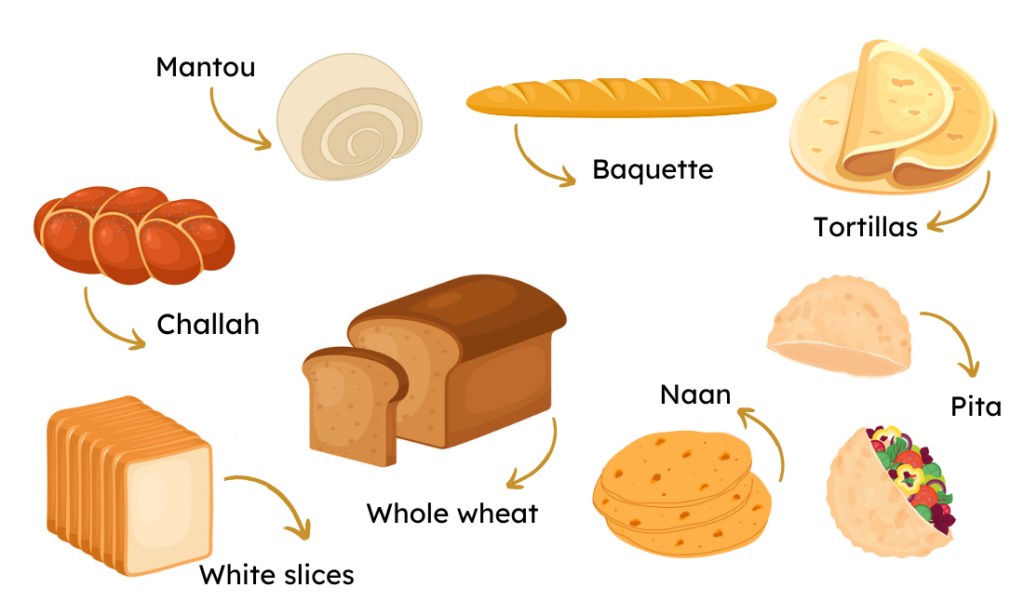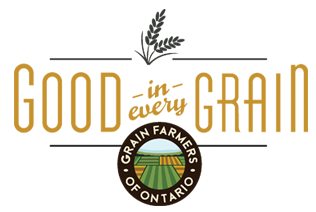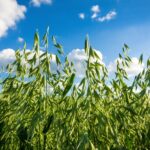Food, culture, and community around the world

Lesson plan + activities
Are your students aware of the integral connections between food and culture? We may not think about it much.
Food is more than nutrition. It provides health, comfort, and security and shapes us within our culture, traditions, identity, and community. It is a particularly important area of learning in a culturally diverse country like Canada.
Grade 2—6 Lesson Plan
Food, Culture and Community Around the World
Preparing for the lesson:
February’s blog, Food for thought: Preparing for Nutrition Month talked about food literacy and its importance for your students. Nutrition month is the perfect time to think about food literacy and food’s many associations. In this lesson, we will continue to build students’ food literacy by exploring food in the context of its association with culture and community.
Students will learn that food among cultures can differ but they also have things in common. Educators will appreciate the Here’s What Kids Eat Every Day Around the World printable pictures used in the hands-on activity.
Curriculum relevance and applications (see end of article for full list):
Grade 2: Social Studies – Heritage and Identity
A1.1, A1.2, A 2.2, A3.2, A3.3, A3.4, A3.6, A3.7
Grade 3: Health and Physical Education – Healthy Living
D1.1, D3.1
Grade 6: Social Studies, History and Geography – The Perspectives of Diverse Communities & People and Environment: Living and Working in Ontario
A2.5, A2.6, A3.11, B1.1
Lesson plan content
Note: The following content has been written so that it could easily be used in your teaching slides. It is adaptable to many classroom topics. Make it yours!
Minds ON!

Did you know?
There is one type of food that is eaten around the world. What do you think it is?
To discuss, take a guess! Compare ideas with the class.
The answer is: Bread!!
Bread exists in many forms: sliced loaves and Indigenous frybread in Canada, baguettes in France, naan in India, pita pockets in the Middle East, tortillas in Mexico, mantou in China, injera in Ethiopia.
The different forms of bread have one thing in common: bread is made from grain.
Grains grow around the world and are an important staple in most cultures. The grain used and the way bread is made depends on the grains people could gather or grow in their environment. It also depends on how they discovered how to cook, such as baking on hot stones or inventing a type of oven. Cultures have their own traditions and it shows in their bread.
Discussion:
As a great opportunity to make a text-to-self connection, ask students to share the types of bread they eat at home. Prompts include:
- What is it called?
- What does it look like?
- How does it taste? Is it sweet, sour, nutty?
- What are its ingredients?
- How often do you eat it?
Did you know?
There are more than 50,000 types of plants in the world that people could eat. Out of all those foods, the staple food for almost everyone is grain. Corn, rice, and wheat together make up more than half (51%) of the food people eat.
For fun!
Watch this YouTube video: How Civilization Was Created By Bread (11 min) for a fun look at how bread developed in different cultures around the world, from Mesopotamia to the TikTok generation.
Lesson content
The different types of bread you saw in the video came from cultures around the world. The bread shows how cultures have developed differently, even though they have a lot in common, such as the need to eat and wanting to enjoy food.
Food and culture
Food gives us the opportunity to gather with people for regular meals or special occasions. Food has become important in many of our activities and even part of religious customs. The ways families and communities found to make favourite dishes became the preferred way to make them—the traditional way. Traditions are part of a culture. It is the same with other things, such as clothing, artifacts, and ceremonies.
Discussion:
- Does your family have a special traditional recipe? Perhaps even a secret family recipe?
- How long has that recipe been in your family?
Food and community
Cultures are made up of communities. They may not always be in the place where the culture and traditions began, but the activities exist wherever people from the culture gather to celebrate.
Here are some examples:

Diwali
Diwaliis a Hindu celebration that is also celebrated in Jainism and Sikhism, other religions founded in India. The festival symbolizes the victory of light over darkness.
The festival is celebrated in the fall and according to the Hindu calendar (Which is lunisolar—based on the sun and moon—not the Gregorian calendar the Western world uses) so the date in Canada is different each year. In 2024, it was on November 1, and in 2025, Diwali will take place on October 21.
During Diwali, which lasts five days, people traditionally light diyas, a type of lamp, and decorate their houses with flowers. People visit friends and family, give gifts, wear new clothes, feed the poor, and feast on traditional foods like karanji, samosas, gajar halwa, puran poli, and many other delicious foods.
Although Diwali originated in India, it is celebrated as a cultural and religious celebration in communities around the world. Note the bright colours and light of this colourful holiday as you watch What is Diwali? and Why is Diwali called the Festival of Lights?
Lunar New Year
Lunar New Year is celebrated in China, where it is called the Spring Festival. It is celebrated in many Asian countries: North and South Korea, Malaysia, the Philippines, Indonesia, Singapore, Indonesia, Mongolia, and Vietnam. It is celebrated in Western nations, too, where people have come from many countries. In Canada, you will hear it referred to as Chinese New Year.
Lunar New Year marks the end of winter and beginning of spring. Its date is based on a lunisolar calendar, so it falls on a different date each year according to Western calendars. It always begins between January 21 and February 21. Each year is associated with one of the 12 animals of the Chinese zodiac. Each animal has its own characteristics. In 2025, the year of the snake, the festival began on January 29.
Festivities last 15 days—from the first new moon to the first full moon of the lunar calendar. In China, people decorate their homes with flowers, as well as oranges and mandarins, which are symbols of luck and good fortune.
Family is very important during the celebrations. They gather to celebrate with fireworks; dancing; drumming; and special foods. There are eight essential dishes of Chinese New Year.
Enjoy the video What is Lunar New Year? or Lunar New Year for Kids, which illustrate the festival for kids,
Food and tradition
Every food began as something growing, so it reflects the place where the ingredients were grown. But tradition isn’t about the soil, water, and temperature plants need. It is about the traditional behaviours that go with food. For example, in Japan it is respectful to finish the food on your plate to avoid waste. But in China it is rude to eat every bite because it suggests your host did not give you enough to eat.
Food and respect
As people have migrated across the globe, they have taken their food, cultures, and traditions with them. It has given us many new foods to try but it has also risked misunderstandings. Think about the foods you see at a food court or in the school lunchroom. They may look and smell different from foods you are used to. That gives you an opportunity to learn about another culture and celebrate food. It should not be an opportunity to say something mean or disrespectful. (Learn more about this topic with our free program The Healthy Respectful Lunchroom.)
Vocabulary
- community – a group of people living in the same place, such as a city or town. It could also be a group of people with something in common, such as your school community.
- culture – the things a group believes, how the people see things, and the ways they do things. The group can be people who are friends, belong to the same religion or race, or are from the same country. Culture is what people have in common—what they eat and wear, their languages, what they find important, and their history.
- grain – wheat or any other cultivated cereal crop used as food. Some examples grown right here in Ontario are barley, corn, oats, soybean and wheat.
- staple – a staple food is one that is a basic and important food that people eat every day
- tradition – the things people do that are passed from one generation to the next. It includes stories, music, songs, crafts, clothing, and ceremonies, as well as things we do in families, such as camping trips every summer. Food is a big part of many traditions.
Action! – Learning Activity
This is a two-step lesson. Adjust it to suit your class or connections to other work you are doing. Note that there are eight pictures of kids and their food; show them in the best way for your student (for example, projected one at a time, printed and distributed one to each to each group, printed and displayed in the classroom). You could have students share with the class how many grains they spotted in their picture, giving the whole class a chance to see each picture.
Suggestions: use this lesson as an art project—have students portray their meals; connect students’ food experiences to Canada’s Food Guide; categorize foods according to their type (e.g., protein, carbohydrates, vegetables); make a chart of foods that are made with grains.
Learning goals:
- Students will learn that food among cultures can differ but they also have things in common.
- Students will learn that food reflects cultures and to respect that connection.
- Students will see that grains are an important part of food around the world.
Supplies:
- Global map (download it here) to print and distribute one per group
- The provided selection of images in Here’s What Kids Eat Every Day Around the World. Project or print. For classroom display only. Download the images here.
- Writing material (sheet of paper for step 1; notebook or writing pad for step 2)
Step 1: Be inspired by a great picture!
- Break off into groups. Select a person to do the writing or take turns writing in the last part of Step 1.
- Study the map of the world provided. Can you find the country where you were born or where you know someone?
- The teacher will show you some pictures that were taken in a project called Here’s What Kids Eat Every Day Around the World.
(Teachers: please note that, under the licensing terms of the source, images may be displayed or shared in the classroom only. No other use is permitted.)
- Study the picture of a child surrounded by food.
- Do your best to locate the country the child is from on the map. You may need to look very closely at the names on the map!
- Identify the food in the images. As a group, name as many foods as you can.
- Write them down. For those you cannot name, try to figure out what they might be made of and write them down (E.g., meat on a skewer, a type of bread).
- Put a star next to the foods you think are made of grain.
- As a class, compare your results. Some topics to talk about:
- How much of the food includes grains? Think corn, oats, rice, soybeans, wheat.
- Have you eaten any of the foods?
- Did you notice a type of bread?
Step 2: Your food journal!
- Be inspired by the images in the project to keep your own food journal for three days (a weekend is good!)
- Write down every food you eat.
- Draw pictures of your food or, if possible, take pictures and print them, then paste them into your journal.
- At the end of the project, bring your journal to class and be prepared to talk about your favourite meals or put your journal on display.
Another version of a food journal (give students an extra five minutes for lunch to write in their journal):
Your lunch food journal!
- Write down everything you eat for lunch for three days.
- At the end of the three days, check off the foods that included grains
- Draw a picture of your favourite food that you ate. Or that you wished you had eaten!
Alternate activities to a food journal:
- Think about what you have eaten for the past three days and write a list of them. How many of them were:
- fruit and vegetables
- made from grains
- protein
- dairy
- Beside each food on your list, write down what kind of food they are (fruit, vegetable, grain, meat or cheese)
- Draw a picture of your favourite food that you eat for a special time. Write its name.
Extension Ideas:
- Have students bring a recipe from home that is made with grains. Suggestion: ask students to bring their recipe on a sheet of paper and decorate the margins or draw a picture of the dish.
- Display the recipes around the class or collect the recipes into a class cookbook.
Alternatives:
- Photocopy the cookbook and send a set of recipes home with each student.
- It could also be a class memento or fund-raiser if a parent(s) would be interested in having the collection bound (e.g., at Staples or a printer) and selling them to the class parents or the school.
Consolidation
As a class, discuss similarities and differences of foods across cultures. Discuss what students have learned about the different cultures of students in their class?
Wrap-up – Reflection
What is your favourite food made with grains? What is one new food that you learned about from your classmates?
Additional Resources
From Good in Every Grain
The Healthy Respectful Lunchroom
A free program to help initiate a discussion with students about considerate behaviour in the lunchroom. Includes a video, discussion guide, PowerPoint presentation, printable worksheets, and a lunchroom pledge poster.
Masa harina, traditional Mexican cooking flour
Masa harina is a flour made from corn, but it isn’t ground directly after harvesting. It is soaked first in a process called nixtamalization.
Grains grown in Ontario:
Barley, corn, oats, soybeans, and wheat
A list of where to find these grains in your food.
Barley
How pearl barley gets from the farm to your fork.
Corn
The types of corn and what we grow in Ontario. Includes links to uses of corn other than as food.
Oats
From ancient Egypt to an Ontario farm near you, oats are a heart-healthy grain.
Soybeans
Getting soybeans from the farm to your fork takes many steps.
Soybeans: Draw with Rob
“Episode 1—Magic Beans” of our Draw with Rob series features children’s author and illustrator Rob Biddulph. He gives students a guided drawing lesson in how to portray some soybean characters and talks about plant growth and the many uses of soy, such as crayons!
Wheat
Why food made from wheat is good for you and dispelling some myths.
From other sources
Video: How Civilization Was Created By Bread
A lively explanation of bread’s role in the development of human history and culture from the ancient Mesopotamians to COVID-era sourdough.
This Is What Kids Are Eating Around The World
Pictorial essay showing kids from around the world and what they eat. Much of their food is grain-based. It depicts many traditional foods that have become familiar due to globalization. The essay includes descriptions and discussion questions.
Books
Awâsis and the World-Famous Bannock by Dallas Hunt and illustrated by Amanda Strong.
Awâsis loses Kôhkum’s freshly baked bannock. Not knowing what to do, Awâsis looks for a variety of other-than-human relatives to help. The story emphasizes the importance of collaboration and seeking guidance from one’s community. For Kindergarten and younger. (For more on bannock: Bannock | The Canadian Encyclopedia)
The Spice Box by Meera Sriram and illustrated by Sandhya Prabhat.
When Rishi’s grandma arrives from India, he wants to help his dad cook curry using the delicious flavors from his family’s spice box. The spice box is more than just fragrant spices—it holds memories passed down from one generation to the next, as each found their place in the wide world. When Rishi drops the precious box, he draws courage and meaning from their past to set things right. A Caliba Golden Poppy Award finalist.
Everyone Loves Lunchtime but Zia by Jenny Liao and illustrated by Dream Chen.
Everyone loves lunchtime except Zia. At school, kids are eating sandwiches and apples. Zia is always nervous about opening her lunchbox. Her dumpling and noodle dishes look and smell different. She dreads lunchtime. But during her birthday week, her parents pack her a different Cantonese dish each day and explain what the food represents: a roast pork bun to bring treasure, soy sauce chicken to bring success, and more. Zia doesn’t want to eat her lunch, but once she starts, she may realize her food could bring good fortune after all. (This book is could accompany Good in Every Grain’s The Healthy Respectful Lunchroom, a collection of free resources to support discussions about considerate behaviour at lunch and a reminder to celebrate our food.)
Thank You, Omu! by author-illustrator Oge Mora.
Everyone in the neighborhood dreams of tasting Omu’s delicious stew! One by one, they follow their noses toward the wonderful aroma. And one by one, Omu offers a portion of her meal. Soon the pot is empty. Has she been so generous that she has nothing left for herself?
Tofu Takes Time by Helen H. Wu and illustrated by Julie Jarema.
Homemade tofu is good, and good things take time. CLICK CLACK WHIRRRR . . . Lin and her grandma, NaiNai, are making tofu from scratch! When NaiNai goes through each step, from blending soybeans with water to molding curd into shape, Lin becomes impatient. But she soon discovers that making tofu not only takes time, but also takes the whole universe!
Bee-Bim Bop! by Linda Sue Park and illustrated by Ho Baek Lee
Bee-bim bop (the name translates as “mix-mix rice”) is a traditional Korean dish of rice topped, and then mixed, with meat and vegetables. In bouncy rhyming text, a hungry child tells about helping her mother make bee-bim bop: shopping, preparing ingredients, setting the table, and finally sitting down with her family to enjoy a favorite meal.
Full List of Curriculum Relevance and Applications
Overall:
Transferable skills across the Ontario curriculum:
- Critical thinking and problem solving
- Collaboration
- Global citizenship
- Communication
Ontario requirement to teach food literacy in grades 1 through 8
Specifically:
Grade 2: Social Studies
A. Heritage and Identity
A1. Why Traditions Change
A1.1 compare ways in which traditions have been celebrated over multiple generations in their family and identify some of the reasons for changes
A1.2 compare their family structure and some of their traditions and celebrations with those of their peers’ families
A2. Past and Present Traditions
A2.2 gather and organize information on some of the past and present traditions and celebrations within their family and the community to which they belong,
A3. Tradition and Heritage
A3.2 identify various groups in their community and describe some of the ways in which their community reflects this diversity
A3.3 identify places and/or countries of personal or familial significance, and locate them on a globe and/or print, digital, or interactive map
A3.4 describe some significant traditions and celebrations of their families, their peers, and their own communities, as well as of some other communities in Canada, including First Nations, Métis, and/or Inuit communities
A3.6 identify some ways in which heritage is passed on through various community celebrations, traditions, teachings, ceremonies, and events
A3.7 identify some ways in which heritage is passed on through various family celebrations and practices, including at least one First Nation, Métis, and/or Inuit family celebration or practice
Grade 3: Health and Physical Education
D. Healthy Living
D.1. Understanding Health Concepts
D1.1 demonstrate an understanding of how the origins of food (e.g., where the food is grown, harvested, trapped, fished, or hunted; whether and how it is processed or prepared) affect its nutritional value and how those factors and others (e.g., the way we consume and dispose of food) can affect the environment
D.3. Making Connections for Healthy Living
D.3.1 explain how local foods and foods from various cultures (e.g., berries, curries, chapatis, lychees, kale, lentils, corn, naan, wild game, fish, tourtière) can be used to expand their range of healthy eating choices
Grade 6: Social Studies, History, and Geography
A. The Perspectives of Diverse Communities
A2.5 evaluate evidence and draw conclusions about perspectives on the historical and/or contemporary experience of a few distinct communities
A2.6 communicate the results of their inquiries, using appropriate vocabulary
A3 Understanding Context: The Development of Communities in Canada
A3.11 identify and describe fundamental elements of Canadian identities
B People and Environment: Living and Working in Ontario
B1.1 Describe connections between features of the natural environment of a region and land use
Agriculture/Agri-Food Themes
- Food is an essential aspect of culture and community
- Grains are a staple food around the world



